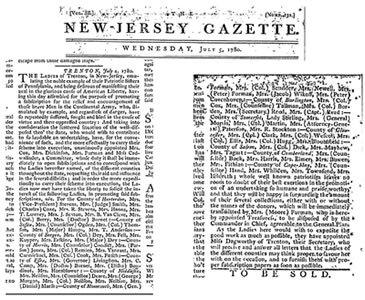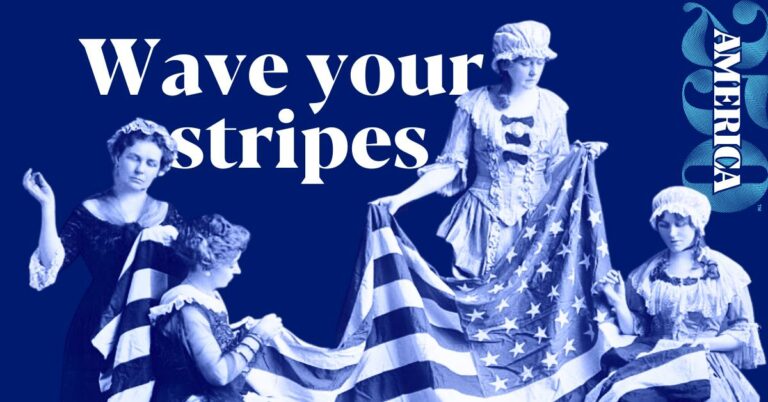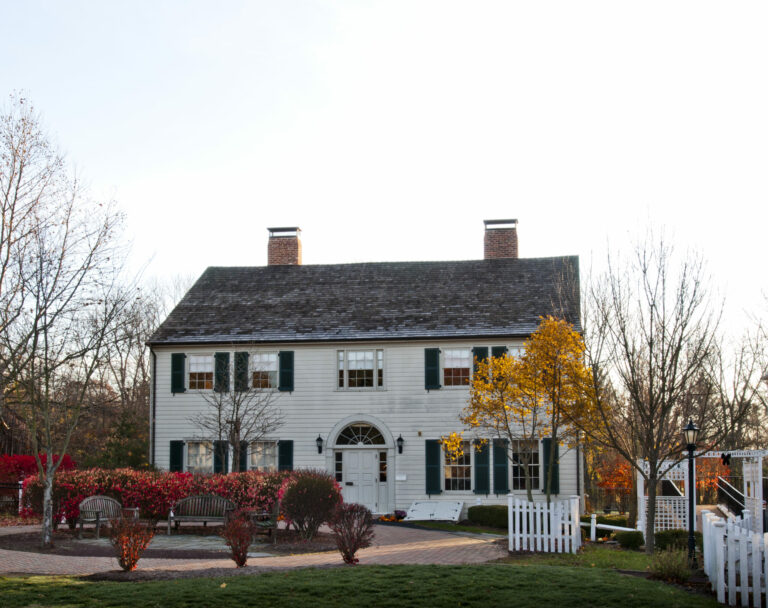A“Jersey Girl” is known for her spirit, drive and “take no prisoners” approach to life. The 18th century women who lived in New Jersey may not have taken up arms in the American Revolution, but many made important contributions to the fight for independence. To commemorate Women’s History Month, Crossroads asked Jan Hunold, Regent of the General William Maxwell Chapter of the National Society Daughters of the American Revolution, to share the stories of some of these women, along with the special challenges in identifying our Revolutionary Jersey Girls.

Is there a Revolutionary Jersey Girl in your family tree? That’s the compelling question faced by women researching their roots to become members of the National Society of the Daughters of the American Revolution, a lineage organization dedicated to community service. To be eligible for membership, each DAR woman must prove that she is descended from an American Revolution Patriot. According to the DAR website, a Patriot is anyone who provided military, patriotic and/or civil service to the revolutionary cause. Many were soldiers in the Continental Army or militias, but other eligible Patriots could have held positions in the U.S. or state governments, provided supplies or offered other aid.
Out of more than 6,000 New Jersey DAR Patriots claimed as ancestors by our members, only 44 are women! Why so few?
First, the realities of 18th century American life reduce the odds. Revolutionary-era women could not serve in the military. They were not allowed to own land or other property in their own right, so they couldn’t render material aid. They were not allowed to hold office. These social and legal constraints of the time prohibit so many women from being classified as DAR Patriots, despite their support for the cause of independence.
Finding proof of service has only gotten harder over time, as DAR standards have gotten stricter. Service must be proven with historical records, documents, or any source that can substantiate or prove a person’s contribution to the cause. Out of the 44 New Jersey women who are currently listed as DAR Patriots, fewer than half have currently-acceptable sources for their service.
In the face of those restrictions, what kind of wartime service would qualify a woman as a Revolutionary Jersey Girl? Interestingly enough, becoming a widow would help a female Patriot’s cause. When their husbands died, whether through military service or otherwise, these women became property owners, a status that 18th century law denied to presently married or never-married women. For that reason, widows could provide material support to the cause.
Several widowed Jersey Girls provided housing to General Washington, and as owners of their homes through the death of their husbands, they can be credited with this service. DAR Patriots Margaret Eaton Berrien,2 Theodosia Bartow Prevost3 and Theodosia Johnes Ford4 all fall into this category. If housing was provided while their husband was alive, the men would have gotten the credit as Patriots.
Other women submitted claims for damages after the war. For example, if the British took one of her horses or destroyed her crops, a widow could seek reimbursement. Again, widows could make claims because their husbands no longer owned everything. If a husband was around, the claims went to him, not his wife. DAR Patriots Hannah Searing Bryant,5 Helena Goltry,6 Lena Ditmars,7 and Elizabeth Stillwagon8 are among the widows with claims filed. You can see these claims at the New Jersey State Archives in Trenton.9
Some women paid a supply tax, required by the new government to raise funds to support the war. A widow could be credited with paying the supply tax. A wife may have paid the supply tax while her husband was off fighting, but it can’t be counted because she technically didn’t have any money of her own to pay it. Mary Kitchen,10 Edus Richards11 and Susannah Sickler12 are women who paid the supply tax after their husbands died.13
Though widows are easier to prove as DAR Patriots, losing one’s husband wasn’t necessary to gain eligibility. One group of women raised funds in support of General Washington’s army. The “Ladies of Trenton” donated money they raised themselves. Their names were published in local papers of the time,14 giving us a large pool of potential DAR Patriots. Three are listed in the DAR Patriot database: Anna Thompson;15 Isabella Scudder;16 and Annis Stockton.17. So many more could join the list if their female descendants were to do the research to join DAR. Is one of these women your ancestor?
There are many fascinating stories about Revolutionary Jersey Girls and their activities during the war. Some of these women are in the DAR Patriot database, but their service would need to be re-proven today if a descendant wishes to join the organization. For example, Elizabeth DeVoe18 and Sarah Stillwell Griffin19 reportedly rescued their husbands from the British, but the documentation is weak for their acts of courage. Peggy Warne20 nursed soldiers, but the tales about her actions are family stories without solid sources. Margaret Mount21 was said to be a spy, but her story appeared in a newspaper column 100 years after the war ended. Their actions have been passed down through the years and are more lore than fact.
How wonderful it would be to find an official document, a letter written at the time, or a contemporary newspaper article that would prove these colorful tales. Perhaps you could be the one to find the thank you letter from General George Washington to a Jersey Girl for the knitted socks she provided to his troops. While the wool may have been owned by her husband, she was the one who spent the time knitting for the troops. And that would count as patriotic service.
You can learn more about Revolutionary Jersey Girls on the DAR website. Under “Ancestors,” you will find the names of Jersey Girls, their service and any relevant service sources. See if you recognize someone from your family. Are you descended from a Revolutionary Jersey Girl? Do you have a family story about a female ancestor that can be proved and might lead to the confirmation of a new Revolutionary Jersey Girl? You can help improve the record of New Jersey DAR Patriot women!
Regardless of the social and legal restraints on women during the American Revolution, Jersey Girls were able to provide support to their families while husbands were away at war, raise funds for the troops and contribute to the general stability of hearth and home during this turbulent time. In other words, Jersey Girls rocked!
Dr. Janice Hunold is regent of the NSDAR General William Maxwell Chapter and has completed the intensive Genealogy Education Program offered by NSDAR. An amateur genealogist for many years, she teaches genealogy workshops, and lectures to genealogy and historical societies and NJDAR chapters throughout the state.
[sta_anchor id=”2″]2 www.dar.org/national-society/genealogy Ancestor A009557.,
[sta_anchor id=”3″]3 www.dar.org/national-society/genealogy Ancestor A203195.
[sta_anchor id=”4″]4 www.dar.org/national-society/genealogy Ancestor A040969.
[sta_anchor id=”5″]5 www.dar.org/national-society/genealogy Ancestor A016319.
[sta_anchor id=”6″]6 www.dar.org/national-society/genealogy Ancestor A209501.
[sta_anchor id=”7″]7 www.dar.org/national-society/genealogy Ancestor A032373.
[sta_anchor id=”8″]8 www.dar.org/national-society/genealogy Ancestor A206948.
[sta_anchor id=”9″]9 wwwnet1.state.nj.us/DOS/Admin/ArchivesDBPortal/index.aspx
[sta_anchor id=”10″]10 www.dar.org/national-society/genealogy Ancestor A211816.
[sta_anchor id=”11″]11 www.dar.org/national-society/genealogy Ancestor A211587.
[sta_anchor id=”12″]12 www.dar.org/national-society/genealogy Ancestor A210986.
[sta_anchor id=”13″]13 You can find these supply tax lists in the “New Jersey Rateables 1778-1780″ articles published in the “Genealogical Magazine of New Jersey” from 1966-1979. See http://www.gsnj.org/wp-content/uploads/2016/09/GMNJ-Author-Title-Listing.pdf.
[sta_anchor id=”14″]14 See the New Jersey Gazette, 5 and 12 July, 1780, for a complete listing.
[sta_anchor id=”15″]15 www.dar.org/national-society/genealogy Ancestor A121813.
[sta_anchor id=”16″]16 www.dar.org/national-society/genealogy Ancestor A207981.
[sta_anchor id=”17″]17 www.dar.org/national-society/genealogy Ancestor A204628.
[sta_anchor id=”18″]18 www.dar.org/national-society/genealogy Ancestor A032177.
[sta_anchor id=”19″]19 www.dar.org/national-society/genealogy Ancestor A048250.
[sta_anchor id=”20″]20 www.dar.org/national-society/genealogy Ancestor A121005.
[sta_anchor id=”21″]21 www.dar.org/national-society/genealogy Ancestor A082417.



